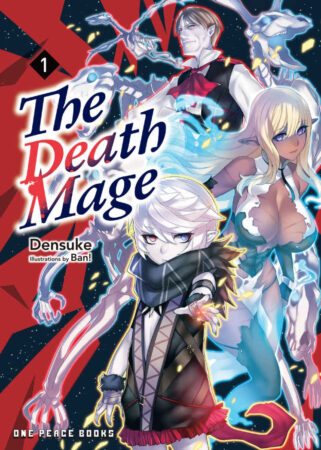Death Mage is Lively
The sub-genre of Japanese “isekai” fantasy light novels, stories about characters either transported to alternate worlds or reincarnated in alternate worlds, is so populated with titles and series that readers may easily and quickly tire of the trope. In the afterword of his first published novel, author Densuke explains the origin of his isekai novel series The Death Mage by saying, “I decided to write this book because I couldn’t find the exact kind of story that I myself wanted to read.” That singular statement largely sums up the nature of the first Death Mage novel. “Death Mage Who Doesn’t Want a Fourth Time” provides a rather unique take on the isekai genre that might not appeal to readers expecting a typical isekai story. On the other hand, fans of the sub-genre seeking something a bit less conventional may appreciate the distinct approach that Death Mage uses.
The briskly paced prologue introduces readers to Japanese high school boy Hiroto Amamiya. Poor Hiroto lived a short, unpleasant life before dying unceremoniously. Due to a cosmic mix-up, he’s reincarnated into an alternate fantasy world in which his life consists entirely of miserable torture and pain. His wretched experience causes him to generate unique death magic. However, before Hiroto can fully make use of his newfound power, his second life comes to an abrupt end. Reincarnated for a third time with all of his prior memories intact, the baby now known as “Vandal,” finds that even in this third life in yet another new world, he’s still yolked with adversity and suffering. Yet despite being a swaddling infant, Vandal decides that this time around he’ll control his own destiny by acquiring the strength and power to defend himself while also exacting revenge upon the people who wronged him.
The bulk of the novel depicts the struggles and adventures of the first eighteen months of Vandal’s life. Despite having two prior lives and nearly forty years of previous life experience, the protagonist is limited by the nature of being a baby. And due to certain limitations placed on him by the god of resurrection, the boy’s previous exhaustive mastery of death magic is now limited to a sort of spiritual necromancy, mostly an ability to communicate with and command spirits. With the exception of the novel’s climactic battle scene, much of the first Death Mage novel is relatively mundane and grounded. Aided by spirits and animated skeletons, Vandal engages in plenty of fights, but the novel’s action scenes are rarely exciting or suspenseful because Vandal is careful to avoid battles that he knows he can’t win. Moreover, especially strong warriors and monsters appear sparsely in this new fantasy world he inhabits. So many of the novel’s action scenes involve Vandal commanding his skeletal minions to defeat common bandits and weak monsters. Much of the novel is devoted to explanation of baby Vandal’s daily life of foraging a barely sustainable existence. The novel may also be said to concentrate heavily on world building, yet the unnamed fantasy world that the primary story occurs within appears to be quite simple and feudal. The novel makes little mention of great religious or political unrest that affects daily living.
Unlike the massive majority of Japanese light novels, Death Mage is primarily expressed in third-person perspective, only switching into the more common first-person perspective during one sub-chapter. Although the novel’s rhetoric isn’t challenging, the use of third-person description rather than first-person makes the reading a bit slower. Moreover, the very grounded, detail-oriented focus of the book keep the pace sluggish although the novel is never boring. The writing contains only one instance of mild profanity. However, in order to emphasize the tragic aspects of the protagonist’s experience and the harshness of the worlds he’s reincarnated into, the descriptions of melee combat violence and descriptions of torture are periodically gruesome. The novel also includes an attempted sexual assault upon a humanoid female monster.
The translation by One Peace Books contains a handful of minor punctuation and grammar errors that most readers likely won’t notice. The translation also contains a couple of marginally more noticeable typos including twice referring to Vandal as “she” instead of “he,” and a few spelling errors including an instance of “creating” that should have been “created,” an instance of “who” that should have been “how,” and an instance of “long” that should have been “longer.” The 312-page novel includes seven monochrome illustrations drawn by Ban!, a one-page afterword by the author, and a seven page glossary that’s mostly redundant yet does contain a few minor details not mentioned in the core novel.
Densuke’s light novel The Death Mage, also known as “The Death Mage Who Doesn’t Want a Fourth Time,” is a book that amply earns a qualified recommendation. While the novel adheres to the conventional tropes of the isekai genre, the details and execution within this particular novel set the book apart from the typical isekai fantasy. Although Death Mage isn’t literally or technically a “survival” isekai story, its explication leans closer to a survival story than a conventional action adventure or slice of life light drama. Readers anticipating a fast-paced or highly gratifying sensationalist story may be disappointed by the slower pace and relatively lower stakes of Death Mage. But fans of the isekai genre searching for something less conventional may find exactly that within The Death Mage.




